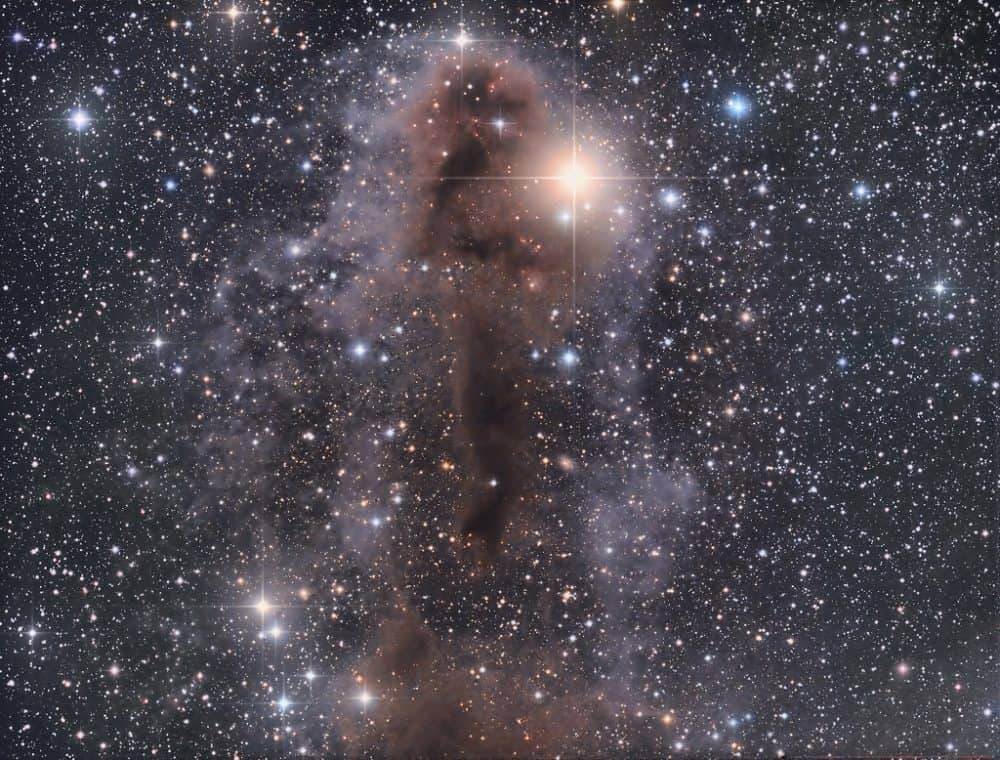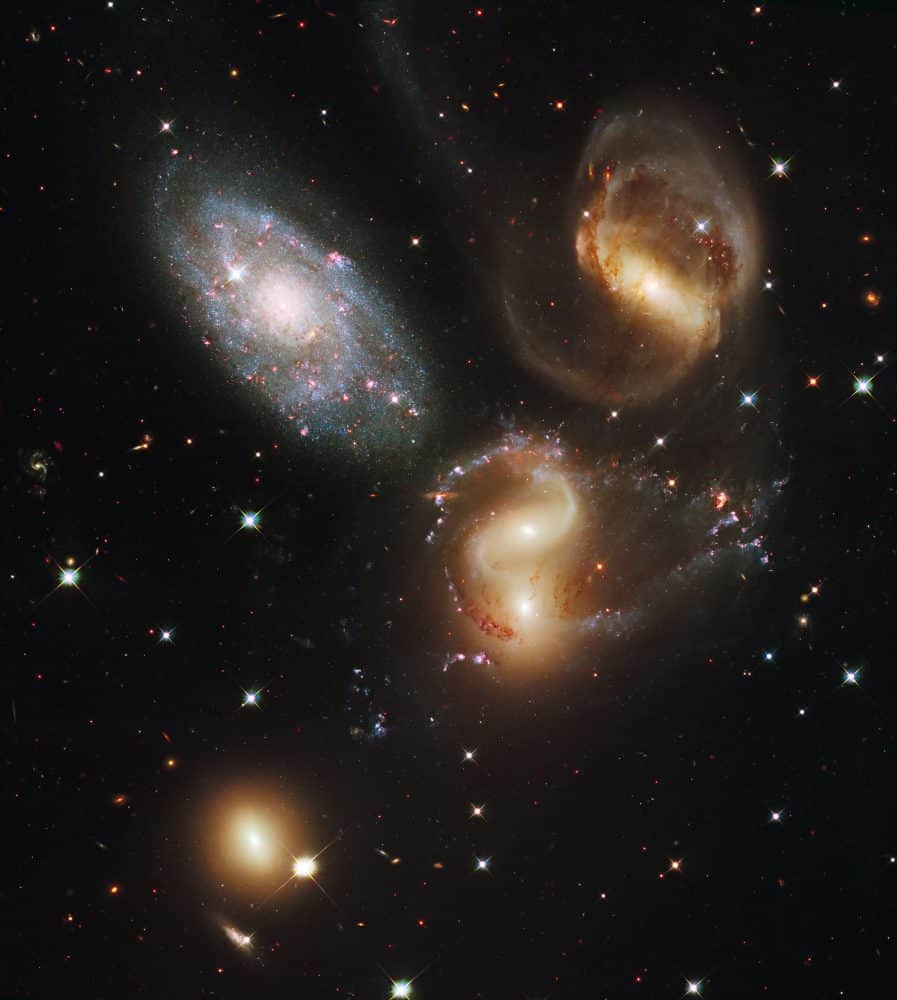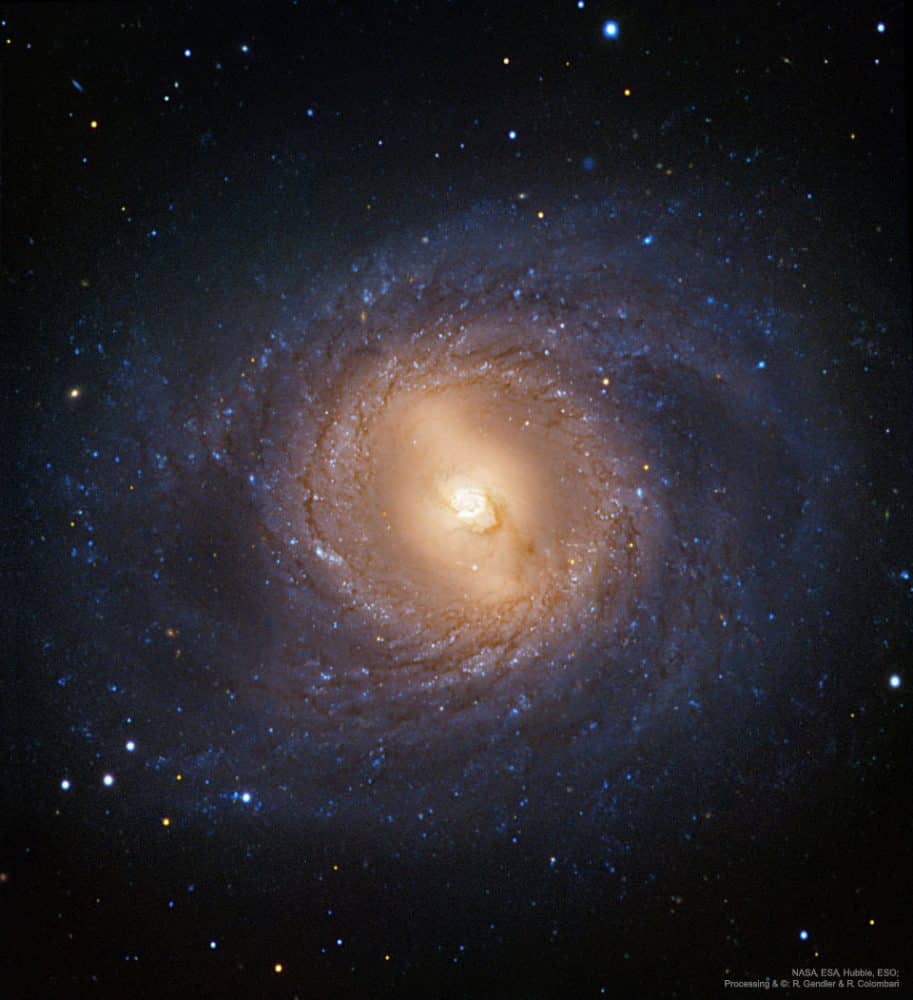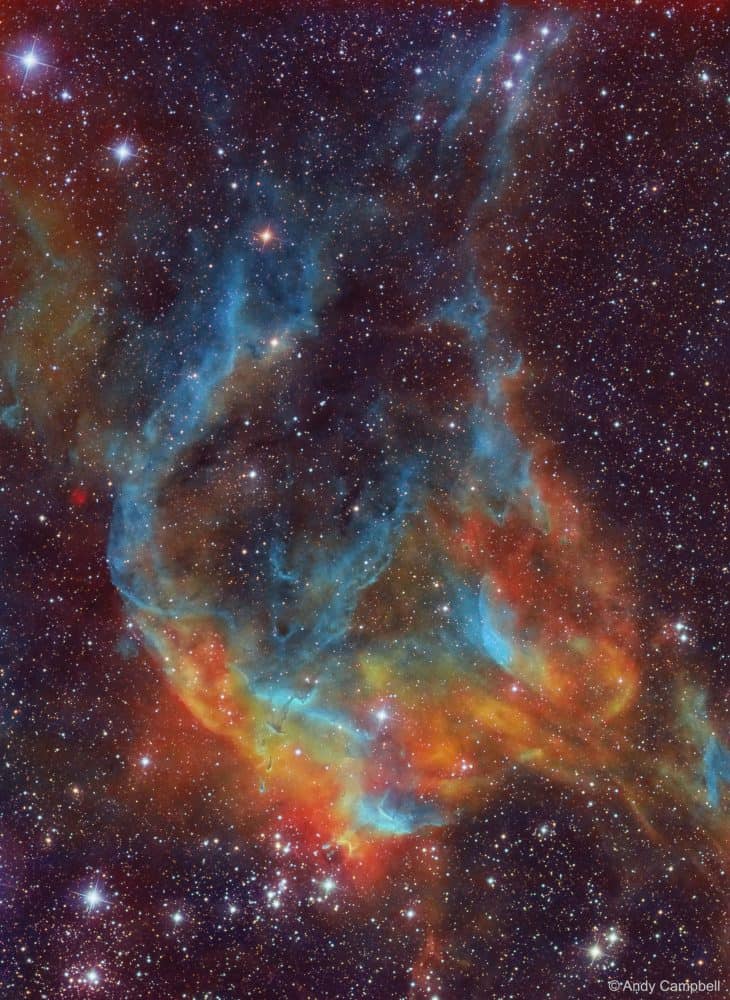Blog
Stars are forming in Lynds Dark Nebula (LDN) 1251. About 1,000 light-years away and drifting above the plane of our Milky Way galaxy, the dusty molecular cloud is part of a complex of dark nebulae mapped toward the Cepheus flare region. Across the spectrum, astronomical explorations of the obscuring interstellar clouds reveal energetic shocks and outflows associated with newborn stars, including the telltale reddish glow from scattered Herbig-Haro objects seen in this sharp image. Distant background galaxies also lurk on the scene, visually buried behind the dusty expanse. The deep telescopic field of view imaged with broadband filters spans about two full moons on the sky, or 17 light-years at the estimated distance of LDN 1251.
more...John Henry Bonham (31 May 1948 – 25 September 1980) was an English musician and songwriter, best known as the drummer for the British rock band Led Zeppelin. Esteemed for his speed, power, fast bass drumming, distinctive sound, and “feel” for the groove, he is regarded by many as the greatest and most influential rock drummer in history. In 2016, Rolling Stone magazine ranked him number one in their list of the “100 Greatest Drummers of All Time”. John Henry Bonham was born on 31 May 1948, in Redditch, Worcestershire, England, to Joan and Jack Bonham. He began learning to play drums at five, making a kit of containers and coffee tins, imitating his idols Max Roach, Gene Krupa and Buddy Rich. His mother gave him a snare drum when he was 10. He received his first drum kit from his father at age 15, a Premier Percussion set. Bonham never took formal drum lessons, though as a teen he had advice from other Redditch drummers. Between 1962 and 1963, still at school, Bonham joined the Blue Star Trio, and Gerry Levene & the Avengers.
Bonham attended Lodge Farm Secondary Modern School, where his headmaster wrote in his report that “He will either end up a dustman or a millionaire.” After leaving school in 1964, he worked for his father as an apprentice carpenter between drumming for local bands. In 1964, Bonham joined his first semi-professional band, Terry Webb and the Spiders, and met his future wife Pat Phillips around the same time. He played in other Birminghambands such as The Nicky James Movement and The Senators, who made a single, “She’s a Mod“, in 1964. Bonham took up drumming full-time. Two years later, he joined A Way of Life, but the band folded. Needing a regular income, he joined a blues group called Crawling King Snakes, whose lead singer was Robert Plant.
In 1967, A Way of Life asked Bonham to return to the group, and he agreed, while keeping in touch with Plant. Plant formed Band of Joy and chose Bonham as the drummer. The band recorded demos but no album. In 1968, American singer Tim Rose toured Britain and asked Band of Joy to open his concerts. When Rose returned months later, Bonham was invited by the singer to drum for Rose’s band, which gave him a regular income. After the breakup of the The Yardbirds in July of 1968, guitarist Jimmy Page formed another band and recruited Plant, who in turn suggested Bonham. Page’s choices for drummer included Procol Harum‘s B.J. Wilson and Paul Francis. However, on seeing Bonham drum for Tim Rose at a club in Hampstead, north London, in July 1968, Page and manager Peter Grant were convinced he was perfect for the project, first known as the New Yardbirds and later as Led Zeppelin. Bonham was reluctant. Plant sent eight telegrams to Bonham’s pub, the “Three Men in a Boat”, in Bloxwich, which were followed by 40 telegrams from Grant. Bonham was also receiving offers from Joe Cocker and Chris Farlowe but he accepted Grant’s offer. He recalled, “I decided I liked their music better than Cocker’s or Farlowe’s.
more...Louis Hayes (born May 31, 1937) is an American jazz drummer. His father played drums and piano and his mother played the piano. Hayes refers to the early influence of hearing jazz, especially hearing big bandson the radio. His main influence was Philly Joe Jones and he was mentored by Jo Jones. His three main associations were with Horace Silver‘s Quintet (1956–59), the Cannonball Adderley Quintet (1959–65), and the Oscar Peterson Trio (1965–67). Hayes often joined Sam Jones, both with Adderley and Peterson, and in freelance settings.
When he was a teenager, he led a band in Detroit clubs before he was 16. He worked with Yusef Lateef and Curtis Fuller from 1955 to 1956. He moved to New York in August 1956 to replace Art Taylor in the Horace Silver Quintet and in 1959 joined the Cannonball Adderley Quintet, with which he remained until mid-1965, when he succeeded Ed Thigpen in the Oscar Peterson Trio. He left Peterson in 1967, and formed a series of groups, which he led alone or with others; among his sidemen were Freddie Hubbard, Joe Henderson, Kenny Barron, and James Spaulding. He returned to Peterson in 1971.
more...Albert “Tootie” Heath (born May 31, 1935) is an American jazz hard bop drummer, the brother of tenor saxophonist Jimmy Heath and the double-bassist Percy Heath.
He first recorded in 1957 with John Coltrane. From 1958 to 1974 he worked with, among others, J. J. Johnson, Wes Montgomery, Art Farmer and Benny Golson‘s Jazztet, Cedar Walton, Bobby Timmons, Kenny Drew, Sonny Rollins, Dexter Gordon, Johnny Griffin, Herbie Hancock, Friedrich Gulda, Nina Simone, and Yusef Lateef. In 1975, he, Jimmy and Percy formed the Heath Brothers. He remained with the group until 1978, then left to freelance. He has recorded extensively throughout his career.
Among his many workshop and classroom teaching assignments, Tootie Heath is a regular instructor at the Stanford Jazz Workshop.
Tootie Heath is now the producer and leader of The Whole Drum Truth, a jazz drum ensemble featuring Ben Riley, Ed Thigpen, Jackie Williams, Billy Hart, Charlie Persip, Leroy Williams and Louis Hayes.
https://www.youtube.com/watch?v=lLIpEO27APM
more...Flamenco Fridays featuring Tientos y Tangos
Tientos is a flamenco Andalusian palo which has a rhythm consisting of 4 beats. It is in the same family as the Tangos, but slower and with different topics, lyrics and mood. Every Tientos becomes a Tangos at the end of the song/dance.[1] Traditionally, cantaor El Marrurro (1848 -1906) has been considered one of the creators of this style. Enrique el Mellizo gave it the modern form by which we know it today. Other famous cantaores who interpreted this style were Antonio Chacón and Pastora Pavón.
Like many Cante Jondo, traditional Tientos lyrics (letras) tend to be pathetic, sentimental, and speak about the lack of love, disillusionment and revenge. Dancers strive to capture this mood in their solos. It can be danced by a man or a woman.
more...Stephan’s Quintet is a visual grouping of five galaxies of which four form the first compact galaxy group ever discovered. The group, visible in the constellation Pegasus, was discovered by Édouard Stephan in 1877 at the Marseille Observatory. The group is the most studied of all the compact galaxy groups. The brightest member of the visual grouping is NGC 7320 that is shown to have extensive H II regions, identified as red blobs, where active star formation is occurring.
Four of the five galaxies in Stephan’s Quintet form a physical association, Hickson Compact Group 92, and will likely merge with each other. Radio observations in the early 1970s revealed a mysterious filament of emission which lies in inter-galactic space between the galaxies in the group. This same region is also detected in the faint glow of ionized atomic hydrogen seen in the visible part of the spectrum as a green arc.
Two space telescopes have recently provided new insight into the nature of the filament, which is now believed to be a giant intergalactic shock-wave (similar to a sonic boom but traveling in intergalactic gas rather than air) caused by one galaxy (NGC 7318B) falling into the center of the group at several millions of kilometers per hour.
more...5-30-62
Central to Darrell Grant’s music is a sense of purpose, agency, and connection to community.
Through eight albums as a bandleader, numerous recordings as a sideman, a growing body of compositions, and two decades of service as an educator and leader in the arts, Grant’s multi-faceted creative projects and innovative initiatives reflect a belief in the extraordinary power of art to communicate, inspire, provoke, inform, and move others to transform society and themselves.
“Darrell Grant is a musician worthy of some serious listening. He is a very fine pianist and composer.”
Speaking to Nat Hentoff for the liner notes to his debut CD Black Art, Grant told the renowned jazz critic that “the longer I play, the clearer it becomes that, at least for me, the goal is to give voice to the meanings behind the music. I have a deep desire to reach people, to communicate something of the things that I am finding to be true, with humor, with love, with silence, with swing, and with passion.” Telling those truths has been the driving force in Darrell Grant’s musical career.
DARRELL GRANT was introduced to international audiences in 1988 as the pianist with the legendary vocalist Betty Carter. He has performed and recorded with such notable musicians as Branford Marsalis, David Sanborn, Esperanza Spalding, John Clayton, Nicholas Payton, James Moody, Kevin Eubanks, Lenny White, Jane Bunnett, Somi, Tom Harrell, Jack Dejohnette, Terence Blanchard, and Art Farmer. He has performed extensively as a bandleader and solo artist throughout the U.S., Canada, and Europe in venues ranging from clubs to major jazz festivals, and been featured on Marian McPartland’s “Piano Jazz” on National Public Radio.
Born May 30, 1962 in Pittsburgh, Pennsylvania, Grant grew up in Denver, Colorado in a musical family. He began classical lessons at age seven and quickly received honors for his prowess on piano. He discovered jazz in school band programs and played family concerts and talent shows. At 15, he joined the Pearl Street Jazz Band, a precocious ensemble of teenaged musicians playing traditional New Orleans-style jazz. The group held down regular professional gigs, recorded two albums, and appeared at regional jazz festivals.
Harold Winston “Harry” Beckett (30 May 1935 – 22 July 2010) was a British trumpeter and flugelhorn player of Barbadian origin.
Born in Bridgetown, Saint Michael, Barbados, Harry Beckett learned to play music in a Salvation Army band. A resident in the UK since 1954, he had an international reputation. In 1961, he played with Charles Mingus in the film All Night Long. In the 1960s he worked and recorded within the band of bass player and composer Graham Collier. Beginning in 1970, he led groups of his own, recording for Philips, RCA and Ogun Recordsamong other labels.
He was a key figure of important groups in the British free jazz/improvised music scene, including Ian Carr‘s Nucleus, the Brotherhood of Breath and The Dedication Orchestra, London Jazz Composers Orchestra, London Improvisers Orchestra, John Surman‘s Octet, Django Bates, Ronnie Scott‘s Quintet, Kathy Stobart, Charlie Watts, Stan Tracey‘s Big Band and Octet; Elton Dean‘s Ninesense. He has also recorded with Keef Hartley, Jah Wobble, David Sylvian and worked with David Murray. He toured abroad with Johnny Dyani, Chris McGregor, Keith Tippett, John Tchicai, Joachim Kühn, Dudu Pukwana‘s Zila, George Gruntz‘s Bands, Belgian quintet The Wrong Object, Pierre Dørge‘s New Jungle Band and Annie Whitehead‘s Robert Wyatt project, Soupsongs, which also featured Phil Manzanera and Julie Tippetts, among other jazz and rock luminaries.
https://www.youtube.com/watch?v=xgio9T2K5LM
more...Armando Peraza (May 30, 1924 – April 14, 2014) was a Latin jazz percussionist and a member of the rock band Santana. Peraza played congas, bongos, and timbales. Born in Lawton Batista, Havana, Cuba in 1924 (although the birth year is uncertain),he was orphaned by age 7 and lived on the streets. When he was twelve, he supported himself by selling vegetables, coaching boxing, playing semi-pro baseball, and becoming a loan shark. His music career began at seventeen when he heard at a baseball game that bandleader Alberto Ruiz was looking for a conga player. Ruiz’s brother was on the same baseball team as Peraza. Despite the absence of experience in music, he practiced and won the audition.
In 1954, while in San Francisco with pianist Dave Brubeck, Peraza met Cal Tjader, Brubeck’s drummer at the time. Jazz critic Leonard Feather recommended Peraza to Fantasy Records with Tjader to record an Afro-Cuban album. The result was Ritmo Caliente, which combined Afro-Cuban rhythms with a jazz sensibility. He was introduced to British pianist George Shearing by bassist Al McKibbon. He spent the next twelve years with Shearing, a collaboration that put Peraza at the front of Afro-Cuban music. He emerged as a composer, writing and recording twenty-one songs for Shearing, such as “Mambo in Chimes”, “Mambo in Miami”, “Ritmo Africano”, “Armando’s Hideaway”, “This is Africa”, and “Estampa Cubana”. These recordings were during the mambo craze in the U.S. and the world. Peraza’s technique and power as a hand drummer became a feature of Shearing’s performances.
He toured all over the world with Shearing, but it was in America that he experienced persistent and institutionalized racism. In Miami during dates with Shearing and Peggy Lee in 1959, Peraza and black members of the band were prohibited from staying at the same hotel as the white musicians. Shearing and Lee resolved the situation by threatening to quit the performance unless Peraza and the others were allowed to stay at their hotel. Shearing’s was one of the first racially integrated jazz groups. While with Shearing, Peraza had opportunity to play with the classical symphonies of Boston, Philadelphia, New York, and Oklahoma City.
In 1959, Peraza joined Mongo Santamaría for the Mongo album with conga drummer Francisco Aguabella, another contemporary and friend of Peraza. “Afro-Blue” became a jazz standard after John Coltrane recorded it. The album combined with Yambo in the compilation Afro Roots in 1972.
First and foremost, M95 is one of the closer examples of a big and beautiful barred spiral galaxy. Visible in the featured combination of images from Hubble and several ground based telescopes are sprawling spiral arms delineated by open clusters of bright blue stars, lanes of dark dust, the diffuse glow of billions of faint stars, and a short bar across the galaxy center. What intrigues many astronomers, however, is the circumnuclear ring around the galaxy center visible just outside the central bar. Although the long term stability of this ring remains a topic of research, observations indicate its present brightness is at least enhanced by transient bursts of star formation. M95, also known as NGC 3351, spans about 50,000 light-years, lies about 30 million light years away, and can be seen with a small telescope toward the constellation of the Lion (Leo).
more...Daniel Robert Elfman (born May 29, 1953) is an American composer, singer, songwriter, and record producer. Elfman first became known for being the lead singer and songwriter for the band Oingo Boingo from 1974 to 1995. He is well known for scoring films and television shows, particularly his frequent collaborations with director Tim Burton. One of Elfman’s notable compositions is The Simpsons theme, which he wrote in 1989.
In 1976, Elfman entered the film industry as an actor. In 1980, he scored his first film, Forbidden Zone, directed by his older brother Richard Elfman. Among his honors are four Oscar nominations, a Grammy for Batman, an Emmy for Desperate Housewives, six Saturn Awards for Best Music, the 2002 Richard Kirk Award, and the Disney Legend Award.
Was born on May 29, 1953 in Los Angeles, California to a Jewish family from Poland and Russia.
more...Eugene Joseph Wright (born May 29, 1923), nicknamed The Senator, is an American jazz bassist, best known for his work as a member of The Dave Brubeck Quartet, in particular on the group’s most famous album, Time Out (1959), with pianist Brubeck, drummer Joe Morello and alto saxophonist Paul Desmond.
Wright had played with the Lonnie Simmons group, and led his own band, the Dukes of Swing, but his big break came when he was recruited by Dave Brubeck. He had a very solid, Kansas-city style, theoretically at odds with, but in practice an important component of, Brubeck’s cool, mannered jazz.
In addition to Brubeck, Wright has played with many jazz stars, including Count Basie, Charlie Parker, Billie Holiday, Carmen McRae, Buddy DeFranco, Cal Tjader, Kai Winding, Karen Hernandez, Sonny Stitt, Gene Ammons, Dottie Dodgion, Lee Shaw, Dorothy Donegan, and Monty Alexander.
Basically Wright is a book of his compositions for bass published by Hansen.
With the death of his bandleader Dave Brubeck on December 5, 2012, Wright is the only living member of the classic quartet.
more...Carl Story (May 29, 1916 – March 31, 1995) was an influential bluegrass musician and leader of his band the “Rambling Mountaineers”. He was dubbed “The Father of Bluegrass Gospel Music” by the governor of Oklahoma. Story was born in Lenoir, North Carolina into a musically inclined family. His father played the fiddle and his mother played the guitar and Story learned to master both fiddle, guitar and clawhammer banjo. In the early 1930s, after winning a fiddle contest, he joined “J. E. Clark and the Lonesome Mountaineers” performing at WLVA in Lynchburg, Virginia. In 1934, he formed the “Rambling Mountaineers” together with banjo player Johnny Whisnant and guitarists Dudley Watson and Ed McMahan. Within a year they played over radio station WHKY in Hickory, North Carolina. It later led to performances at WSPA in Spartanburg, South Carolina and WWNC in Asheville, North Carolina. They recorded for ARC in 1939 and Okeh Records in 1940; however, these recordings were never issued. Story played with Bill Monroe in 1942 as a fiddler – replacing Howdy Forrester who had been drafted – but eventually he was drafted too in October 1943.
After his discharge from the Navy in 1945, he began performing with his “Rambling Mountaineers” on the “Mid-Day Merry-Go-Round” show at WNOX in Knoxville, Tennessee. In 1947, he recorded for the Mercury label. At the recording sessions of 1947, Story temporarily labelled his band the “Melody Four Quartet”. During the 1950s, Carl Story’s “Rambling Mountaineers” performed on the “Farm and Fun Time Show” at WCYB in Bristol, Virginia and on the “Cas Walker Show” over WBIR-TV in Knoxville, Tennessee. His “Mountaineers” also appeared on radio stations WAYS in Charlotte, North Carolina, WEAS in Decatur, Georgia, and WLOS in Asheville, North Carolina. He had a new recording contract on Columbia Records in 1953. Two years later he was back to Mercury Records. In 1957, he switched label to Starday Records where he stayed for eighteen years. In 1960, Story began working as a deejay for WFLW in Monticello, Kentucky. Beginning in the 1960s, and for the next twenty years, Story toured extensively throughout the USA and Europe. He signed another recording contract with CMH Records in the mid-1970s. He settled down in Greer, South Carolina working as a deejay over WCKI in Greer.
more...This chromatic cosmic portrait features glowing gas and dark dust near some recently formed stars of NGC 3572, a little-studied star cluster near the Carina Nebula. Stars from NGC 3572 are visible near the bottom of the image, while the expansive gas cloud above is likely what remains of their formation nebula. The image‘s striking hues were created by featuring specific colors emitted by hydrogen, oxygen, and sulfur, and blending them with images recorded through broadband filters in red, green, and blue. This nebula near NGC 3572 spans about 100 light years and lies about 9,000 light years away toward the southern constellation of the Ship’s Keel (Carina). Within a few million years the pictured gas will likely disperse, while gravitational encounters will likely disperse the cluster stars over about a billion years.
more...Leland Bruce Sklar (born May 28, 1947) is an American electric bass guitarist and session musician. He is a member of the Los Angeles-based instrumental group The Section, who served as the de facto house band of Asylum Records and were one of the progenitors of the soft rock sound prevalent on top-40 radio in the 1970s and 1980s. Besides appearing as the backing band on numerous recordings by artists such as Jackson Browne, Carole King, and James Taylor, the Section also released three solo albums of instrumental rock. Both in The Section and separately, Sklar has contributed to over 2,000 albums as a session musician. He also has toured extensively with major rock and pop acts, and recorded many soundtracks to films and television shows.
Sklar studied at California State University, Northridge. It was during that time he met James Taylor, who invited him to play bass at some venues. They both thought that the work would be short-term, but soon Taylor’s career took off with his first hit records, and Sklar came into the limelight. He was soon asked to record with others, and his long career began. In the 1970s, Sklar worked so frequently with drummer Russ Kunkel, guitaristDanny Kortchmar, and keyboardist Craig Doerge that they eventually became known as “The Section” and recorded three albums under that name between 1972 and 1977.
more...
More Posts
- Ed Thigpen Day
- Earl Hines Day
- World Music with Tuareg Music of the Southern Sahara
- Daily Roots with the The Simpkin Project
- The Cosmos with vdB 24
- Terry Bozzio Day
- Johnny Frigo Day
- Bunk Johnson Day
- Flamenco Fridays with Victor Manuel Rosa
- Daily Roots with Vivian Jones
- The Cosmos with M94
- John Scofield Day
- Butch Ballard Day
- World Music with Daniel Bellegarde
- Daily Roots with Dennis Alcapone
- Merry Christmas 2019
- The Cosmos with NGC 2237
- Don Pullen Day
- Don Alias Day
- Chris Kenner Day



